Diamonds in The Sky – Part 4: Carbon Planets (Episode 2/3)
Are these amazing carbon planets common in our universe? If so, how would they form?
Join me on this stunning scientific journey to find out!
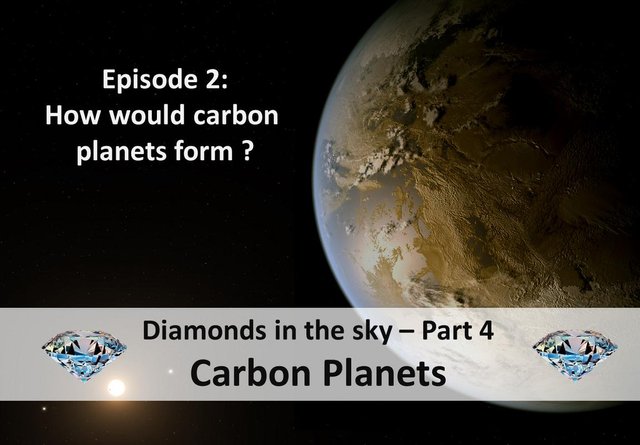
In the previous post, we landed on a carbon planet. What we saw just cut our breath away, and not because of the carbon monoxide and carbon dioxide smoggy atmosphere, but because of the view!
Imagine an oily ocean of tar in which flows heavy oil rivers, a shore made of diamond sand, lakes of gasoline and volcanoes spitting diamonds when erupting!


Up to a few years ago (2010), carbon planets were suspected to be the most common type of Earth-sized planets in the universe. Yet, recent improvements in the acquisition and the analysis of the data, as well as the refinements of planetary formation models, are leading an intense discussion within the scientific community about this idea.
In this paper, we will continue our exploration of carbon planets by looking at the factors that lead to their formation. For that, we will blend some astrophysics with chemistry by looking at what gives stars their chemical compositions and how we, little humans, can determine these.
The accretion disc that forms around a star originates from the same gas cloud from which the star was born. Consequently, the resultant planetary system is assumed to naturally have a similar composition than the star itself. This composition is what will lead to the prevalence of carbon planet or silicate planets (like Earth).
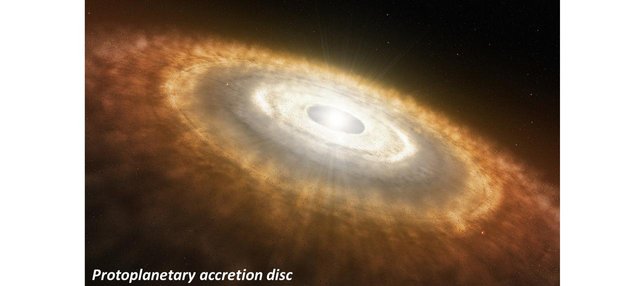
1/ The legacy of primordial stars
First, let’s briefly remind ourselves how stars came (and still come today) into existence.
During the primordial nuclear synthesis that occurred after the Big Bang, the only nuclei that formed were hydrogen (75%) and helium (25%). The early universe was composed of vast clouds of this gaseous mixture. The homogeneity of the clouds was nearly perfect, just nearly…
Local fluctuations in density allowed gravity to kick in and amplify these inhomogeneities into lumps of matter. Gravity relentlessly tortured these lumps making them collapse on themselves further (the more dense they became, the more gravity would accelerate the collapse).
This process led to the birth of the first stars. These primordial stars were only composed of hydrogen and helium, thus no building material for planets existed yet. It is most likely no planets existed at this time.
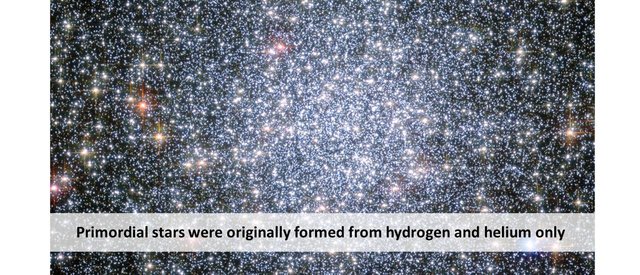
Many of these stars are thought to have been massive, hence synthetizing in their core all the chemical elements up to iron via standard fusion. Elements heavier than iron (up to bismuth) were also synthesized for the most massive ones via a process called the “slow process”. All the other elements were formed when the massive stars exploded into a supernovas.
The legacy of these primordial stars is… the Mendeleev periodic table of elements.

Note that the synthesis of these elements is still going on now inside all massive stars, and is probably going to continue for quite a while. In other words, our universe is enriching itself with heavy elements as it gets older. Hence, it is enriching itself with planets!

2/ Stars of second generation get inheritance!
Primordial stars did not consume all of the hydrogen and helium in the universe, far from that! A lot of fuel remained (and still remains) for the formation of new stars. The only difference is that the clouds of hydrogen are now enriched with many new building blocks for nature to play with: carbon, silicon, oxygen, iron, magnesium, sulfur etc…
The stars that rise from these enriched clouds have the composition of their parent cloud. The accretion disc of material orbiting around them in their early days also has an enriched composition. The heavier elements are the source of the material from which are built up planets, so ultimately, this accretion disc will clump up into planetesimals and finally into planets.
So in the end, it is the original composition of the gas cloud in which stars are born that determines what the planets orbiting around them will look like…
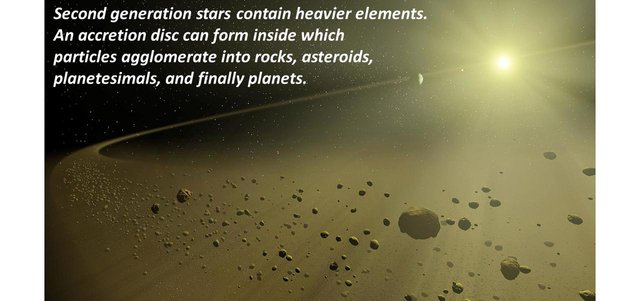
3/ The composition of stars
In order to predict what the planets orbiting a star are made of, we need to determine the composition of the star. How can this be done? Just by looking at them! Let’s figure this one out together
3-a / Stars are black bodies
Stars are considered to be nearly perfect black bodies. A body is said to be a black body when it absorbs and emits all electromagnetic radiation. The radiation emitted will depend on the temperature of the body.
Take for example a piece of steel. Heat it. For the first hundred degrees, it will appear to remain unchanged. Heat it up further, it will start glowing a dark red color, then red, then orange then yellow and then melt or vaporize. If the steel didn’t melt or vaporize, it would continue through the colors of the rainbow, turn green, blue, violet before becoming darker again, but actually emitting ultraviolet.
Even you yourself are a black body. At a temperature of 37 C, the human body emits light in the infra-red region. Some animals, like snakes, can see in the infrared region. This is why they are able to hunt hot blooded animals at night…
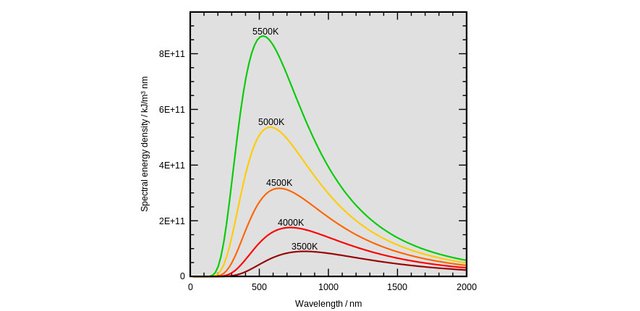
You can actually calculate the maximum wavelength of a black body’s spectrum by knowing its temperature (and vice versa) and applying Wien’s law (lambda is the wavelength in m, and T the temperature in Kelvin).

So when you look at the color of a star, you can determine its surface temperature…. Red stars are in the 3000-4000 K range, yellow stars like our sun around 5000-6000K, and blue stars will have surface temperatures above 7000-8000K.
Let’s look at the sky. The Orion constellation contains good examples. On the top left there is a giant red star called Betelgeuse it surface temperature is quite low (3500K) compared to that of our sun (5800K). Its red color is clearly distinguishable with the naked eye. On the other hand, Rigel, on the lower right corner is a very hot blue giant, with a surface temperature exceeding 12000K. Its peak wavelength is therefore in the close ultraviolet range, we can see with the naked eye a dominant blueish color.

3-b / A star's composition is determined by its absorption spectra.
Even if a star has a specific color, it does emit in all wavelengths (see the ideal black body spectra in the previous paragraph). The perceived color is just being determined by the predominant wavelength (even a red star emit small amounts of blue light).
That allows for an ideal continuous spectrum that will pass through the atmosphere of the star (photosphere) and provide an absorption spectrum. The dark lines on the spectrum will correspond to the presence of elements in the close surrounding of the star.
You can consult the Atomic Physics Series I published recently for more details on the physical processes behind that analytical technique..
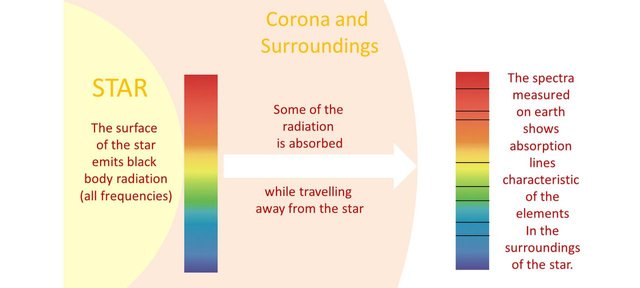
4/ The composition of planetary systems
By analyzing these spectra, scientists are able to evaluate the presence and concentration of various elements in the surroundings of a star. The standard indicator used is the ratio of the element to the hydrogen content, for example [Fe]/[H]. The values being very small, this indicator is expressed in a logarithmic scale.
When studying the composition of potential planets around a given star, other indicators are more pertinent thus more commonly used by exo-planetologists. Two are fundamental in dictating what kind of planet we might encounter if we visited that star’s system. The elemental ratio of carbon to oxygen (C/O), and the elemental ratio of magnesium to silicon (Mg/Si).
According to most planet formation models, The C/O ratio of the star acts as a threshold in regards to what the planets orbiting that star will mainly be composed of. If the C/O ratio is above 0.8, most of the oxygen is consumed in oxidizing the carbon into CO, CO2 and carbonates. There is not enough oxygen left to oxidize silicon into silicates. Thus the silicon when condensing carbonizes into silicon carbide SiC. The planets forming in such an environment would mainly be composed of silicon carbide and other carbonates. This process would lead ultimately to the carbon planets described in the previous episode.
If the C/O ratio is less than 0.8, the oxygen oxidizes the silicon providing silicate as the main material for planet building. The Mg/Si ratio determines what type of silicate is formed, thus has a large impact on the resulting geochemistry of the planet.
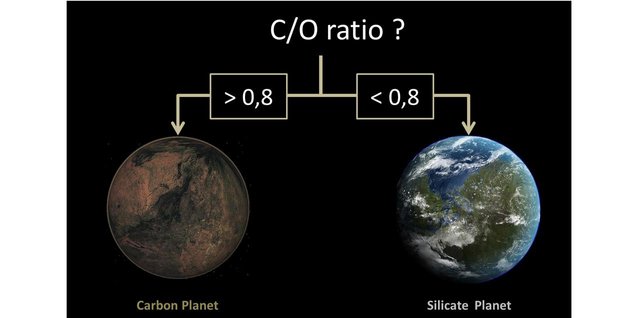
5/ We need an extra episode!
During the research I carried out prior to writing this article, I realized a lot of recent progress has been made in regards to the acquisition and analysis of the spectral data of stars. In addition, astro-chemistry models of planetary formation have refined significantly by adding many dynamic factors that were originally neglected. The results show that these additional factors would have quite an impact on the composition of planetary systems.
Consequently, another episode is required to fully embark on this scientific journey. The latest data I was able to put my hands on is less than one week old! That proves how the subject is hot! This recent work is pretty solid and tends to confirm the latest trend in answering the question: are carbon planets common in the Universe?
So allow me a cliffhanger: I invite you to read my next post of this series to find out!
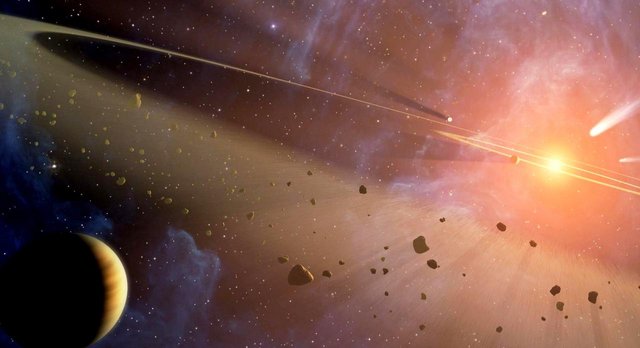

Image Credits:
- The post's thumbnail background was created by re-colorising an NASA artistic view of an exoplanet (link)
- The protoplanetary accretion disc artistic view is by ESO/L. Calcada (link)
- The picture of primordial stars is actually a globular cluster by NASA/ESA/Hubble Heritage (link)
- The accretion disc showing rock formation is by wilyD and public domain (link)
- The black body curve is by 4C (link)
- The picture of Orion's constellation is public domain and by Ronald Carson (link)
- The Earth-like planet used in the C/O illustration is by Daein Ballard (link).
- The final artist view of a forming planetary system is by NASA/JPL-CAltech (link)
- All other pictures and visual elements originate from either Pixabay or wikimedia commons
- All text and illustration added on pictures are by @muphy
- Illustration of absorption spectra by @muphy
Reference and text sources:
- C/O vs Mg/Si ratios in solar type stars: The HARPS sample (Suarez-andres et al.) (link)
- "The Diversity of Extrasolar Terrestrial Planets" proceedings of the International Astronomical Union. 5 (Symposium S265): 399–402. (link - pdf download available)
- The Compositional Diversity of Extrasolar Terrestrial Planets - In-Situ Simulations (Jade C. Bond, David P. O’Brien and Dante S. Lauretta ) (link)
- https://en.wikipedia.org/wiki/Carbon_planet
- Earth-Like Planets May Be Made of Carbon (Georges Musser) - Scientific American (link)
- C/O and Mg/Si ratios of stars in the solar neighborhoud (John M. Brewer, Debra A. Fischer) - (link)
- The carbon-to-oxygen ratio in stars with planets (P.E. Nissen, A&A 552, A73 - 2013). (link)

Diamonds in the sky series - Previous episodes:
- Part 1: The story of how our sun will become a massive diamond floating in the sky.
- Part 2: Clathrate Stars
- Part 3: Diamond Oceans (Episode 1/2)
- Part 3: Diamond Oceans (Episode 2/2)
- Part 4: Carbon planets (Episode 1/3)

Hi,
I’m @muphy (see intro post),
My life revolves around music production, teaching sciences, and discovery through travel.
You enjoyed that post? Resteem and Upvote!
You are interested in these topics? Follow me!
Being A SteemStem Member
Thanks Steemstem for all your support. I am glad to be part of such a vibrant community!
Do you know that this is been confirmed experimentally only a couple of months ago thanks to ligo and virgo? BY confirmed, I mean this has been observed live :)
Yes, I read an article about this in last months edition of "La Recherche" (Page 50). We were hearing about gravitational waves (GW) astronomy since their first detection. Well, that was quite an amazing proof of the power of this technique to learn about our universe!
These GW are real scouts, telling us where to look. And, once all our eyes are on the phenomena, we can follow the evolution of the phenomena (here fusion of 2 neutron stars). Being really far, it is so faint we would never have seen it otherwise. One observation was the reddening of the halo of ejected matter around the phenomena that can only be explained by the formation of heavy nuclei like Tellure and Cesium.
I am quite excited about other mysteries GW will allow us to solve, just by telling us where to look. I heard somewhere there was a Ligo-like machine being built in India, and another that will power up in Japan by 2020 (Kagra) in order to improve triangulation of the sources. That's so cool!
We are right into the gastrophysics era (this term is used for about 2 years, and it is not what you may naively think it is ;) )
Your comment intrigued me and I was endlessly falling on this: New Science of Eating by Charles Spence... why is @lemouth talking about the chemistry of food now?
A few google pages later... the mystery was solved lol!
Yes we are, yet gastrophysics is intricately linked with particle physics. Don't you think? That's why I love both :-)!
Thank you professor for this scientific course, I always benefit from you.thank you so much for this huge effort.
I am happy your enjoyed the carbon planet adventure.
The third episode will be soon in preparation.
See you there and don't hesitate to ask questions if you have any.
The title of your post making think I can become a future diamond sky miner
On the carbon planet, diamonds should be quite easy to mine. Just bend down and pick up a common rock, haha!
On the other hand, you still need to get there... If you find a cheap way, let me know, I'll join you for the ride ;-)
Lemme call my buddy Elon, seems he has a ride we can hitch on.
Who's Elon?
Elon musk
Ah yeah right, lol!
His first step is Mars... it's a little short.. but it is a first one :-)
Universe is a great thing the more we explore and dive into the more we know !
Yes, it is full of surprises.
With all the techniques we are deploying to explore it, new stunning answers are found, as well as twice as many questions ;-)
Great work and excellent post very informative thanks @muphy resteemed
Thank you @Barca, I am glad you enjoyed the voyage to these mysterious planets!
Steemit all the way.
Great post tnx for sharing I just upvoted.
Check out my new posts if you can plz
upvote resteem comment @gclipse
Thank you,
Yes Steemit to the moon, and beyond, up to carbon planets filled with diamond.